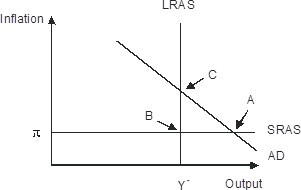A typical indifference curve is upward sloping
a. True
b. False
Indicate whether the statement is true or false
False
You might also like to view...
Refer to the figure below. In response to gradually falling inflation, this economy will eventually move from its short-run equilibrium to its long-run equilibrium. Graphically, this would be seen as 
A. long-run aggregate supply shifting leftward B. Short-run aggregate supply shifting upward C. Short-run aggregate supply shifting downward D. Aggregate demand shifting leftward
How does a monopoly transfer consumer surplus to itself?
What will be an ideal response?
By the time Paul Volcker took office as the new Federal Reserve chairman in 1979, the inflation rate exceeded 10%. By 1982 the unemployment rate soared to 9.7% and inflation was cut to 6.2%
By the end of 1986 the unemployment rate was brought down to 7% and the inflation rate was brought further down to 1.9%. Which of the following is an appropriate description of the mechanism behind the Volcker Disinflation? A) The AD curve shifted right due to the autonomous tightening of monetary policy which explains the lowering of the unemployment rate between 1982 and 1986. B) With the Federal Reserve raising interest rates, the AD curve shifted to the left lowering the equilibrium level of inflation but inducing a negative output gap, which explains the lower inflation rate between 1979 and 1982 at the cost of a higher unemployment rate over the same period. C) The LRAS curve shifted left due to the tightening of monetary policy generating a positive output gap or a negative unemployment gap which explains the lowering of the unemployment rate between 1982 and 1986. D) all of the above E) none of the above
Because the U.S. economy failed to snap back from a mild recession in 2001, the Fed pushed the federal funds rate down to 1%. What effect did this have on the economy?